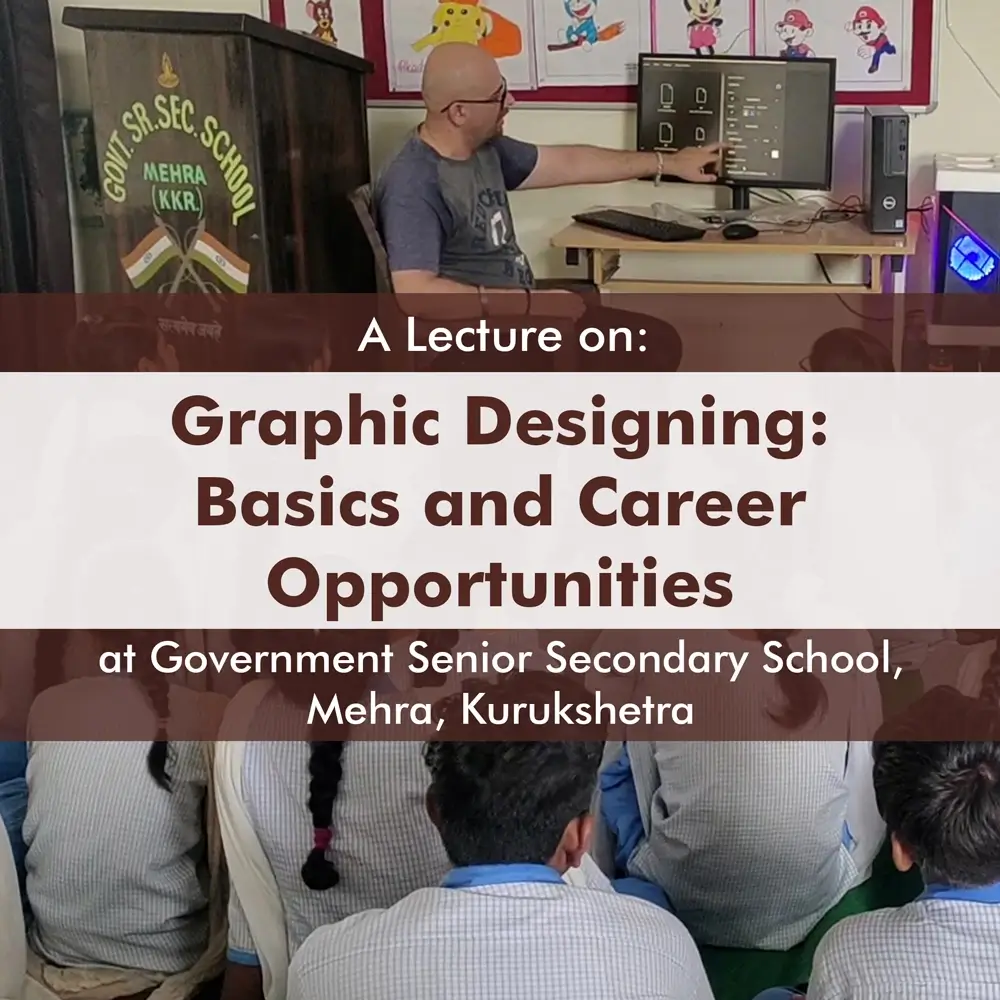Professional Graphic Designing Course
Basic and Advanced Graphic Designing CoursesThis is a dedicated page for Graphic Designing Course. If you are looking for Graphic Designing Services, Portfolio or Blog, click below:
Welcome to Our Professional Graphic Designing Course!
We are thrilled to have you join us on this exciting journey of unleashing your creativity and honing your design skills. Our comprehensive graphic designing course is designed for everyone interested in art, technology, and visual communication. Throughout the program, you will be guided by industry experts and experienced professionals, learning design software, typography, branding, and more.
In this course, you’ll work on hands-on projects, collaborate with peers, and receive constructive feedback to enhance your creative thinking and problem-solving abilities. Our goal is to provide you with a well-rounded education that aligns with industry standards and current design trends.
Get ready to explore the world of colors, shapes, and ideas as we embark on this journey together. Let’s create something extraordinary and make your mark in the captivating realm of graphic design!
Why to Become a Graphic Designer?
Benefits to Learn Graphic DesigningGraphic designing offers an exciting and rewarding career path for individuals with a passion for creativity and visual expression. Here are some compelling reasons to consider pursuing a career in graphic design:
- Creative Outlet: Graphic design provides an exceptional creative outlet, allowing professionals to transform ideas and concepts into visually engaging artworks. It offers a perfect balance between artistic expression and problem-solving, making it an appealing career for those who seek to combine their artistic talents with practical applications.
- Diverse Opportunities: The demand for skilled graphic designers spans across various industries, including advertising, marketing, web design, publishing, entertainment, and more. This diversity in opportunities enables graphic designers to explore different domains, work on a wide range of projects, and constantly learn and adapt to new trends and technologies.
- Impactful Communication: As a graphic designer, one has the power to influence and shape how information is presented and perceived. Effective visual communication is crucial for conveying messages, promoting brands, and engaging audiences, making graphic designers key players in building strong connections between businesses and their target markets.
- Continuous Evolution: The field of graphic design is dynamic and ever-evolving. Designers are continually exposed to new design trends, software updates, and innovative techniques. This constant evolution ensures that the work remains fresh and exciting, providing endless opportunities for growth and development.
- Freelance and Entrepreneurial Opportunities: Graphic design offers flexibility in terms of employment options. Many graphic designers choose to work as freelancers or start their design studios, giving them the freedom to work on diverse projects and be their own boss.
Who Can Become a Graphic Designer?
Anyone with an interest in art, design, and visual communication can enroll for a graphic designing course. There are no strict prerequisites or specific educational backgrounds required to start learning graphic design. Whether you are a student, a working professional looking to switch careers, a freelancer seeking to enhance your skills, or simply someone passionate about creativity, you are welcome to enroll in a graphic designing course.
The course is open to individuals of all ages and backgrounds who wish to explore their artistic talents, learn design principles, and master design software. Whether you have prior experience in design or are a complete beginner, a well-structured graphic designing course will cater to different skill levels and provide a gradual learning curve. Here are the types of individuals who can thrive as graphic designers:
- Creative Individuals: Above all, graphic design demands creativity. Whether someone has a natural talent for art and design or has cultivated a creative mindset through practice and exploration, the ability to think creatively and innovatively is a core trait of successful graphic designers.
- Art and Design Enthusiasts: Individuals who have a keen interest in art, aesthetics, and design principles are well-suited for graphic design. Having an eye for detail, color, and composition is essential in creating visually compelling and harmonious designs.
- Tech-Savvy Individuals: Proficiency in design software and digital tools is crucial in the modern graphic design landscape. Individuals who enjoy working with technology and are willing to stay up-to-date with the latest design software and trends can excel in this field.
- Effective Communicators: Graphic designers often collaborate with clients, marketing teams, and other professionals. Strong communication skills are vital to understand project requirements, convey design ideas, and address feedback effectively.
- Problem Solvers: Graphic designers are problem solvers at heart. They analyze design challenges and find creative solutions that not only meet the client’s objectives but also resonate with the target audience.
- Lifelong Learners: As the design industry evolves rapidly, graphic designers must be open to continuous learning and improvement. Being receptive to feedback and seeking opportunities for growth ensures that designers remain relevant and innovative in their work.
Contents of Basic Graphic Designing Course
Module 1: Introduction to Graphic Design
- Understanding the role of graphic design in various industries
- Historical overview of graphic design
- Principles of design: color theory, typography, composition, and balance
Module 2: Introduction to Design Software
- Familiarization with design tools like Adobe Photoshop, Illustrator, and InDesign
- Understanding the workspace and essential tools
- Basic image editing and manipulation techniques
Module 3: Typography
- Fundamentals of typography and typefaces
- Creating and formatting text in design software
- Typography hierarchy and readability
Module 4: Image Editing and Composition
- Understanding image formats and resolution
- Image retouching and enhancement techniques
- Composing visuals using multiple elements
Module 5: Layout Design
- Designing effective layouts for various mediums
- Creating posters, flyers, and brochures
- Grid systems and alignment principles
Module 6: Logo Design
- Principles of logo design
- Creating simple and memorable logos
- Logo design process and case studies
Module 7: Introduction to Color Theory
- Understanding color models: RGB, CMYK, and Pantone
- Color psychology and its impact on design
- Creating harmonious color palettes
Module 8: Designing for Social Media
- Graphics for different social media platforms
- Creating engaging posts and stories
- Understanding social media design trends
Graphic Designing Course: Add-On Modules
These Modules are Designed for Learners who want to choose a Specialization for their Career in Graphic Designing.Add on: Graphic Designing for Branding
Module 1: Brand Identity Design
- Developing brand personas and brand attributes
- Designing logos, stationery, and brand guidelines
- Creating brand style guides
Module 2: Packaging Design for Brands
- Principles of packaging design
- Designing product packaging that aligns with brand identity
- Mockup creation and presentation
Module 3: Brand Collateral Design
- Designing marketing materials like business cards, letterheads, and envelopes
- Design consistency across various brand touchpoints
Add on: Graphic Designing for Print & Packaging Designing
Module 1: Print Design Essentials
- Understanding print design requirements and specifications
- Designing for different print materials: brochures, flyers, posters, etc.
- Preparing files for professional printing
Module 2: Layout and Publication Design
- Designing layouts for magazines and newspapers
- Creating visually appealing spreads and covers
- Typesetting and formatting for publications
Module 3: Packaging Design for Print
- Packaging design considerations for different products
- Designing labels and packaging artwork
- Mockup creation and presentation for client approval
If you are Enrolled in Print and Packaging Designing Course You Don’t need to Enrol to this course. It is already covered in that course.
Add on: Graphic Designing for Digital Marketing
Module 1: Digital Marketing Design Concepts
- Understanding the role of graphic design in digital marketing
- Designing visuals for email marketing campaigns
- Creating graphics for social media ads
Module 2: Web Advertisements
- Designing banner ads and interactive web ads
- Best practices for effective digital advertisements
- A/B testing for ad design optimization
Module 3: Designing for Content Marketing
- Creating visually appealing infographics
- Designing eBook covers and lead magnets
- Visual content for blog posts and articles
If you are Enrolled in Digital Marketing Course You Don’t need to Enrol to this course. It is already covered in that course.
Graphic Designing for Website / UI / UX Designing
Module 1: Introduction to Web Design
- Understanding the basics of web design
- Responsive design principles
- Wireframing and prototyping
Module 2: User Interface (UI) Design
- Designing intuitive and user-friendly interfaces
- Creating UI elements like buttons, icons, and navigation bars
- Designing for different screen sizes and resolutions
Module 3: User Experience (UX) Design
- Conducting user research and usability testing
- Information architecture and user flow
- Enhancing user experience through design
Module 4: Web Graphics and Assets
- Creating web banners, sliders, and promotional graphics
- Optimizing graphics for web use
- Designing web-specific icons and imagery
If you are Enrolled in Website Designing Course You Don’t need to Enrol to this course. It is already covered in that course.
Add on: Graphic Designing for Animation and Videos
Module 1: Introduction to Motion Graphics
- Understanding motion graphics and animation principles
- Introduction to Adobe After Effects and other animation tools
- Creating animated logos and text effects
Module 2: Video Editing and Post-Production
- Basics of video editing using Adobe Premiere Pro
- Adding graphics, titles, and transitions to videos
- Color grading and video enhancement techniques
Module 3: Animated Social Media Content
- Designing animated content for social media platforms
- Creating short video ads and promos
- Adding motion graphics to video content
If you are Enrolled in Animation and Video Composition Course You Don’t need to Enrol to this course. It is already covered in that course.
Note:
Please note that the syllabus can be adjusted based on the course duration, the level of expertise of the students, and the availability of resources and software. Additionally, practical projects, assignments, and real-world case studies will be included throughout the course to reinforce learning and build practical skills.
For Diploma, Internship and Industrial Training Contact Us
Minimum Theory Maximum Practical
Interview Preparation
Regular Assignments
Job Placement Assistence
Enroll Now and Become a Successful Graphic Designer
Boost Your Career!
Enrol Now




